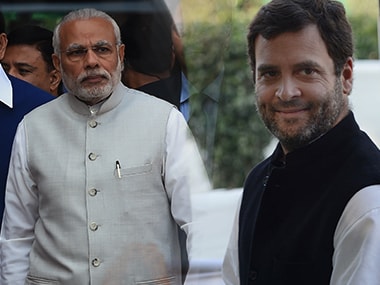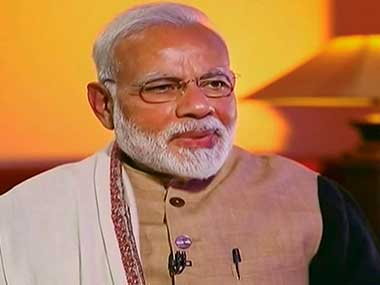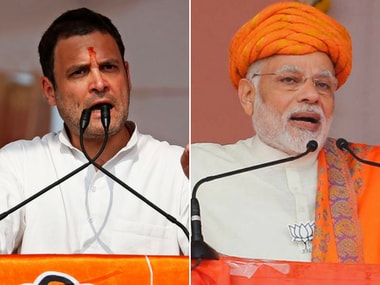Rahul Gandhi is in high spirits. He has reasons to be. After all, Congress has won three by-election seats in a poll-bound state. That’s quite an achievement. Plus the Sensex has crashed by 840 points a day after Arun Jaitley presented his final Budget. The Congress president was briefly silent while emerging from the Parliament after the Budget presentation (when he possibly didn’t know what to tell reporters in absence of a briefing) but soon rediscovered his voice.
4 years gone; still promising FARMERS a fair price.
4 years gone; FANCY SCHEMES, with NO matching budgets.
4 years gone; no JOBS for our YOUTH.
Thankfully, only 1 more year to go.#Budget2018— Office of RG (@OfficeOfRG) February 1, 2018
In Parliamentary language, the Sensex just placed a solid 800 point No Confidence Motion against Modi's budget. #BasEkAurSaal
— Office of RG (@OfficeOfRG) February 2, 2018
In two tweets, Rahul took a dig at the Budget and termed the Sensex crash as a ‘no-confidence’ motion. He also coined a hash-tag to indicate that Narendra Modi’s time is up. The attempt to cash in on middle-class angst was clear. The Congress president is making a few elementary mistakes. Let’s start with a bit of perspective.
If Sensex crashes are to be seen as ‘no-confidence’ motions then Manmohan Singh should have resigned five times over in 2008 alone. Even a cursory look at the top five Sensex crashes show all have occurred during the UPA regime. The sixth-worst crash came in 2009 when the BSE sensitive index nosedived 870 points to close at 14,043 "on concerns over the high fiscal deficit set by the Union Budget."
If Sensex crashes are to be seen as ‘no-confidence’ motions then Manmohan Singh should have resigned five times over in 2008 alone. Even a cursory look at the top five Sensex crashes show all have occurred during the UPA regime. The sixth-worst crash came in 2009 when the BSE sensitive index nosedived 870 points to close at 14,043 "on concerns over the high fiscal deficit set by the Union Budget." One may find Rahul Gandhi’s trolling ironical, but sadly the Congress president is immune to ferrous jibes. Ask his designer Burberry jacket.
Conflating short-term market speculation with politics is daft. It leads to hilarious conclusions. For instance, if a single-day fall of 2.63 percent in bourses that wiped out Rs 4.6 lakh crore of investor wealth is a vote of “no-confidence” against Modi and his Budget, how do we explain the index’s 2000-point rise in one month? Sensex crossed Mount 34k on 26 December and moved beyond the 35,000 mark on 17 January. If the markets were to recover the losses, will this same "bad budget" suddenly turn "brilliant"?
Markets are driven not by any algorithm or politics, but sentiment. It is possible that punters and investors were reacting adversely to Jaitley’s reintroduction of 10 percent tax on the sale of equities if the total capital gains in a year cross Rs 1 lakh. Gains below that threshold won’t be taxed. Gains before 31 January, 2018 would be exempted.
The move has evidently displeased Dalal Street and sparked a heated debate. Some such as Andy Mukherjee of Bloomberg feel that the move may scare away foreign investors while some feel that it is an excellent move to tap into a kitty of Rs 3.67 lakh crore which has largely accrued to corporates and LLPs. Apart from swelling the coffers in an election year, it is also a nudge towards redeployment of surpluses towards manufacturing instead of financial assets, as the finance minister put it in his speech.
The fear expressed by bourses is exaggerated. There are more compelling reasons behind the imposition of LTCG tax.
According to Taimur Baig, managing director at DBS Bank, "By global standards, 10 percent capital gains tax is not that prohibitive...
"There are many countries who have had very successful capital gains regimes with significant degree of compliance and at much higher rate. It will not be a big deal at all," he told Boomberg Quint.
Chief investment officer of Motilal Oswal Manish Sonthalia told Boomberg Quint that "there is a ton of cash sitting on the side, waiting to buy into every drop... Unless there’s something really fundamentally serious, I don’t expect a steep correction."
V Anantha Nageswaran, an eminent economist, has praised Jaitley for bringing LTCG under the tax net, calling it a "job well done" to end the "welfare state for Indian stock market investors".
In an earlier piece, he had called it "bizarre and regressive" to exempt the rich from paying taxes on long-term capital gains. He wrote in livemint: "No respectable country that is not a financial tax haven provides this exemption for capital gains arising out of stock market investments. Capital gains are taxed everywhere... A democratically elected government in a predominantly poor country has no reason to exempt returns to capital from tax."
Economist Haseeb Drabu felt that “given the reality that money will come into equities because of the lack of alternatives, there is no reason for the government to forgo a potentially large kitty."
At 3.3 percent, the projected fiscal deficit is still manageable, and given India’s macroeconomic stability under NDA it possibly won’t be long before the markets regain their composure. It could be risky for Rahul to rely on market speculation for his politics.
The Congress president’s buoyancy is based on an assumption that the middle class is angry with the prime minister. This isn’t an easily quantifiable segment. The Economist reckons that "India has a hole where its middle class should be" in terms of purchasing power. It is varied, layered and resists easy identification. Some of them buy the latest model of iPhone while a large number of this section has never seen the inside of an airplane. "If nearly 300m Indians count as middle class, as HSBC has proclaimed, some of them make around $3 a day," writes the newspaper.
Fluid as it is, the median is vocal, ambitious, aspiring and given India’s scale, it is not a segment that is easily ignored. The middle class wants opportunities and likes to see India remain integrated with the global economy.
Counted among Modi’s staunch backers, they were hoping for some relief by way of tax exemptions or rejig of income tax slabs from the government in an election year. Apart from a standard deduction for salaried employees which translates into a negligible rise in cash-in-hand and some allowances for senior citizens, the finance minister had precious little for this segment.
The Congress president evidently believes that all that he needs to do is to tap into this anger and Modi’s ouster is certain. He is mistaken. If Modi is ousted, that won’t be due to the fact that the middle class has deserted him in favour of Gandhi. If their anger persists, they’d rather vote NOTA.
BJP wouldn’t have been scraped through in Gujarat had it not been for the urban middle class who were unimpressed by Rahul’s Gabbar Singh Tax jibe. The incumbents faced massive erosion in rural voter base, an area where Modi concentrated the most in his Budget. Some may say this is good politics.
Rahul’s optimism is misplaced because the middle class suffers from a historical, deep, indelible cynicism when it comes to the Congress, especially the Gandhis. For decades post Independence this self-made class built its life carefully around the regressive policy frameworks of 1970s and 80s and carried on with their austere lifestyle with a degree of stoicism.
Not until PV Narasimha Rao’s economic liberalisation that this segment witnessed some prosperity. Rao, an outlier in Congress, opened the windows, which were further widened by Atal Bihari Vajpayee. The 10 UPA years have served to only confirm the middle class’s lack of confidence in Congress.
There’s one more reason why Rahul might be misreading middle class anger against Modi. Unlike the stoicism of the past, the middle class is now more invested in the government. It is restive, responsive, vocal, even loud. In social media, it has a platform to vent its spleen. Modi has been a pioneer in harnessing the power of social media to connect with his electorate. This relationship goes deep.
Their displeasure with Modi is evident but they also recognise that his government at least stands for something. It is willing to take risks instead of sitting on the fence, even at the cost of antagonising own voter base. It has implemented disruptive policy decisions with all the finesse of a mace but hasn’t been guilty of inaction. The aspirational middle class understands this.
This anger, therefore, is sharp but might not be a bankable commodity for a politician who comes across as insincere, ready to hunt with the hound and run with the hare. Rahul shouldn’t bet on it.
Published Date: Feb 03, 2018 18:22 PM | Updated Date: Feb 03, 2018 18:26 PM





















